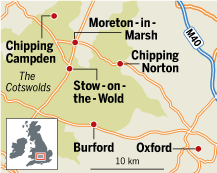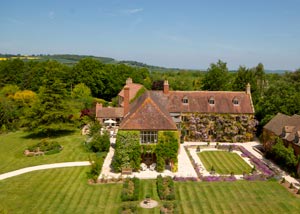UK property: Moreton-in-Marsh offers Cotswold charm for commuters

Roula Khalaf, Editor of the FT, selects her favourite stories in this weekly newsletter.
Moreton-in-Marsh is the quintessential Cotswold market town, steeped in history and popular with tourists. Yet its real importance to today’s property market lies in its position and distance from London, marking what estate agents call “the Cotswolds dividing point”.
The hills, towns and villages that make up the Cotswolds stretch 25 miles by 90 miles across western England, with those parts closest to London some 60 miles away. They are designated as an area of outstanding natural beauty and characterised by houses made from honey-coloured local stone. What gives parts of the area an added attraction – and a hefty premium on property values – is that they are within reasonable commuting distance from the capital.
Moreton-in-Marsh (the locals just call it Moreton) sits in the north Cotswolds. Its town centre, dating back to the 13th century, hosts a weekly open-air market with stalls nestled between pubs and houses that were once coaching inns for the horse-drawn carriages making their way north from London. The town’s transport tradition is continued in less romantic style today by direct trains to Paddington station, used by hardy commuters prepared to travel 90 minutes each way to enjoy a home life in the Cotswolds.
Farther north or west into the Cotswolds and a daily commute to the capital is less attractive; Honeybourne and Evesham, for example, are more than 100 minutes from Paddington, while Cheltenham is two hours away. But times tumble to the east and south of Moreton: Kingham is 80 minutes to London and Charlbury only 70, while Oxford takes about an hour.

The 4,000 residents of Moreton-in-Marsh – located 80 miles northwest of central London and close to the borders of Gloucestershire, Warwickshire and Oxfordshire – therefore find themselves at a financial dividing point.
“To the east, several of the finest properties have been bought in recent years and turned into Cotswold versions of London homes. The properties are upgraded as much as their listed status allows and outbuildings have become home cinemas, gyms or games rooms,” says Jonathan Bramwell of The Buying Solution, the buying agency arm of Knight Frank.
Many houses in this eastern patch are in conservation villages and small towns; most are three- to five-bedroom houses, but often have little more than an acre of garden. A typical example is a four-bedroom Cotswold stone house, parts of which date from the 13th century, with a small separate cottage, in Milton-under-Wychwood. It is on sale with Savills for £1.75m.
The most expensive homes in this area are within what Bramwell calls “the Daylesford triangle”. This is named after Daylesford Organics, a fashionable restaurant and farm-shop complex seven miles from Moreton. “The triangle’s points are Stow-on-the-Wold, Chipping Norton and Burford. The existence of the shop is critical for second-home buyers from London because they use Daylesford outlets at Notting Hill, Pimlico and Selfridges and they want to live near the original outlet in the Cotswolds,” he says.

This autumn there are few high-end properties on the market, but one example is near Chipping Campden. This is a six-bedroom house with a separate bungalow and lodge, accompanied by an unusually large 12 acres of land, priced at £3.5m with Savills.
Against those prices, Moreton appears good value. A detached property in the town costs an average of £537,000 while a terraced home sells at £272,500, according to website Zoopla. A four-bedroom house with five acres on the edge of town is on sale for £1.3m with Jackson Stops & Staff.
But go further west and prices are better still, sometimes as much as 30 per cent cheaper than similar homes on the London side of the Cotswolds. Agents say buyers tend to be in their 60s, or people in their 30s – moving from London or Oxford – who are seeking a better lifestyle for their young families and don’t need to travel to London every day.
“So many of our clients in the north and west Cotswolds want good schools. There are excellent grammars at Cheltenham and Stratford, most local state schools have excellent standards and there are private schools,” says Edward Clarkson, an agent at The Buying Solution. “Some buyers also want equestrian facilities as the area has dressage yards, three-day events, hunting and Cheltenham racecourse is an easy drive away.”

Close to Broadway – a neatly manicured Worcestershire village of period homes nine miles west of Moreton – there is an 8,300 sq ft, four-bedroom Cotswold house with 15 acres of land, including a two-bedroom cottage, on sale for £1.95m through Hayman-Joyce estate agents.
There are substantial family estates in the area, especially to the west of the town. These rarely come on to the market, but do provide individual properties or farms to rent. The complaint from estate agents on either side of Moreton is the lack of available stock for sale this year.
“Family houses are urgently required to meet the demand,” says Sam Butler of Butler Sherborn. His agency has seen a 20 per cent rise in inquiries over the first half of 2013. He claims many homes have recently been sold after competitive bids, while some have found buyers so rapidly they have not even required publicising on the open market.
“We’ve seen increased interest from international buyers over the past 12 months. They’re predominantly Europeans, particularly from Spain and Italy, but also Americans and Japanese,” says Simon Merton of Strutt & Parker’s Moreton office.
If these market descriptions sound like those prevailing in central London, the reason is simple. “I’m born and bred in the Cotswolds and I’ve seen property in and around Moreton become a function of London,” says Jonathan Bramwell. “Now it’s bonuses, bankers and lawyers from the capital fuelling what goes on. The Cotswolds are changing.”
——————————————-
Buying guide
● Moreton prices rose by an average 2.78 per cent in the three months to September this year but by only 5.21 per cent over the previous five years
● There were 15 reported crimes in the town in July this year
● Developers have appealed against the refusal of planning consent for new homes on the town fringes
What you can buy for
£500,000: A three-bedroom detached house in the town
£1m: A three-bedroom converted mill
£5m: A manor house in a nearby village with 10 to 30 acres of land
Comments